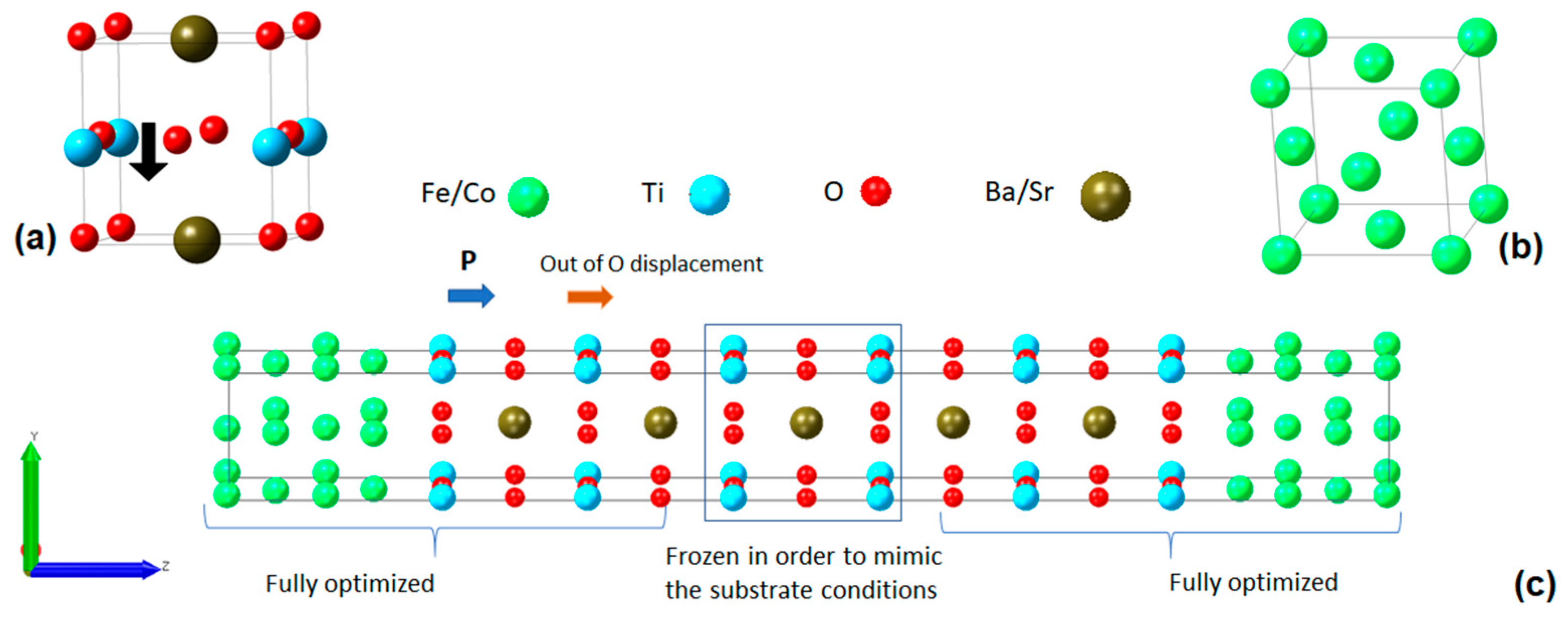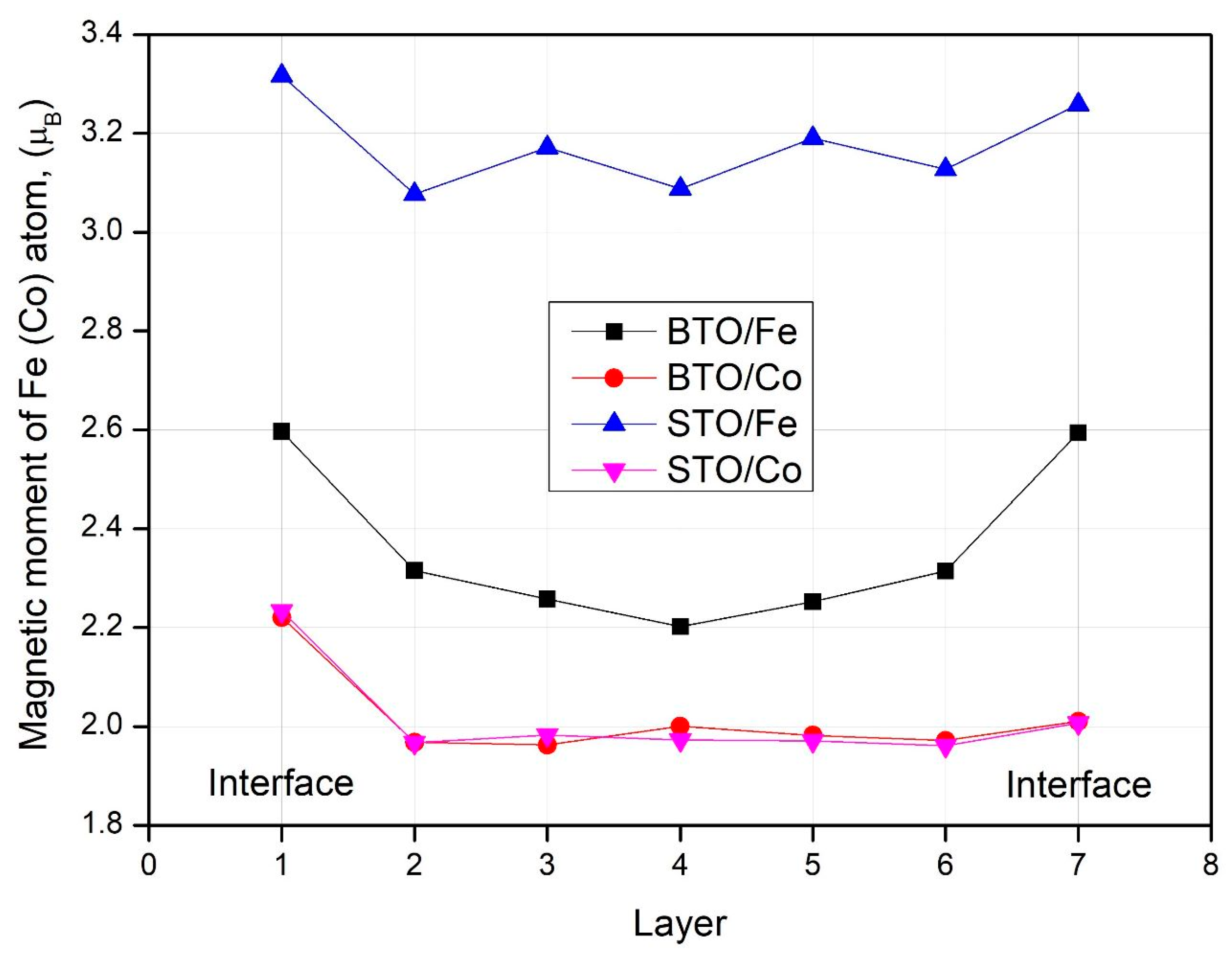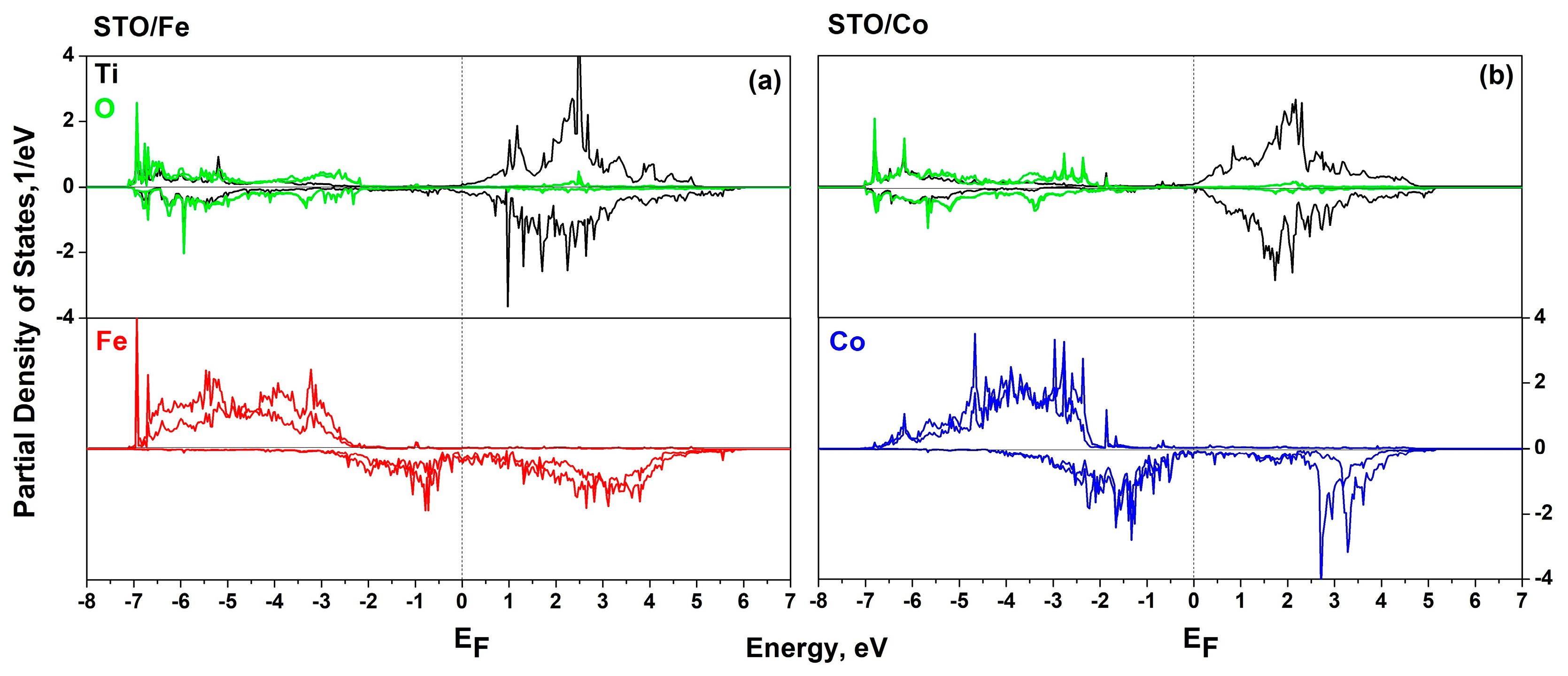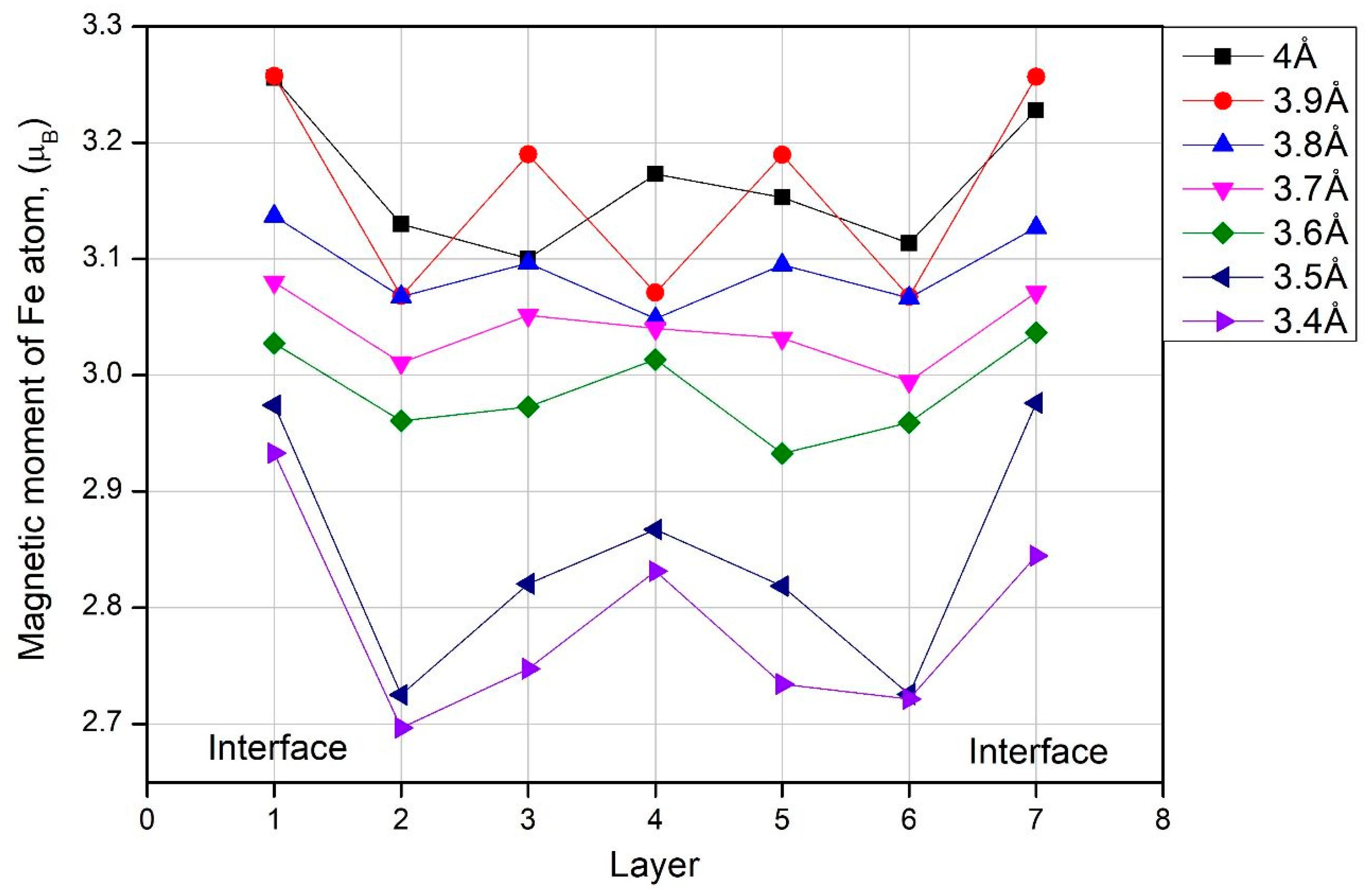Ab Initio Characterization of Magnetoelectric Coupling in Fe/BaTiO3, Fe/SrTiO3, Co/BaTiO3 and Co/SrTiO3 Heterostructures
Abstract
:1. Introduction
2. Material and Method Details
3. Results and Discussions
3.1. Spin-Polarized Calculations: Structural and Magnetic Properties
3.2. Spin–Orbit Calculations
3.3. Density of State Calculations
3.4. Striction Calculations
4. Discussion and Conclusions
Author Contributions
Funding
Institutional Review Board Statement
Informed Consent Statement
Data Availability Statement
Acknowledgments
Conflicts of Interest
References
- Guo, W.; Posadas, A.B.; Demkov, A.A. Epitaxial integration of BaTiO3 on Si for electro-optic applications. J. Vac. Sci. Technol. 2021, 9, 030804. [Google Scholar] [CrossRef]
- Spaldin, N.A.; Ramesh, R. Advances in magnetoelectric multiferroics. Nat. Mater. 2019, 18, 203–212. [Google Scholar] [CrossRef] [PubMed]
- Fredrickson, K.D.; Demkov, A.A. Switchable conductivity at the ferroelectric interface: Nonpolar oxides. Phys. Rev. 2015, 91, 115126. [Google Scholar] [CrossRef] [Green Version]
- Niranjan, M.K.; Wang, Y.; Jaswal, S.S.; Tsymbal, E.Y. Prediction of a switchable two-dimensional electron gas at ferroelectric oxide interfaces. Phys. Rev. Lett. 2009, 103, 016804. [Google Scholar] [CrossRef] [PubMed] [Green Version]
- Piyanzina, I.; Mamin, R. Toward the ferroelectric field-effect transistor on BaTiO3/LaMnO3 heterostructure: DFT investigation. J. Mater. Sci. 2022, 57, 1–10. [Google Scholar] [CrossRef]
- Liu, X.; Tsymbal, E.Y.; Rabe, K.M. Polarization-controlled modulation doping of a ferroelectric from first principles. Phys. Rev. 2018, 97, 094107. [Google Scholar] [CrossRef] [Green Version]
- Weng, Y.; Niu, W.; Huang, X.; An, M.; Dong, S. Ferroelectric control of a spin-polarized two-dimensional electron gas. Phys. Rev. 2021, 103, 214101. [Google Scholar] [CrossRef]
- Won, S.S.; Seo, H.; Kawahara, M.; Glinsek, S.; Lee, J.; Kim, Y.; Jeong, C.K.; Kingon, A.I.; Kim, S.H. Flexible vibrational energy harvesting devices using strain-engineered perovskite piezoelectric thin films. Nano Energy 2019, 55, 182–192. [Google Scholar] [CrossRef]
- Yao, J.; Song, X.; Gao, X.; Tian, G.; Li, P.; Fan, H.; Huang, Z.; Yang, W.; Chen, D.; Fan, Z.; et al. Electrically driven reversible magnetic rotation in nanoscale multiferroic heterostructures. ACS Nano 2018, 12, 6767–6776. [Google Scholar] [CrossRef]
- Hou, Y.; Wei, Y.; Yang, D.; Wang, K.; Ren, K.; Zhang, G. Enhancing the Curie Temperature in Cr2Ge2Te6 via Charge Doping: A First-Principles Study. Molecules 2023, 28, 3893. [Google Scholar] [CrossRef]
- Wang, K.; Ren, K.; Hou, Y.; Cheng, Y.; Zhang, G. Physical insights into enhancing magnetic stability of 2D magnets. J. Appl. Phys. 2023, 133, 11. [Google Scholar] [CrossRef]
- Lu, N.; Zhang, P.; Zhang, Q.; Qiao, R.; He, Q.; Li, H.B.; Wang, Y.; Guo, J.; Zhang, D.; Duan, Z.; et al. Electric-field control of tri-state phase transformation with a selective dual-ion switch. Nature 2017, 546, 124–128. [Google Scholar] [CrossRef] [PubMed] [Green Version]
- Borek, S.; Braun, J.; Ebert, H.; Minár, J. Multiferroic heterostructures for spin filter applications: An ab initio study. Phys. Rev. 2015, 92, 174408. [Google Scholar] [CrossRef]
- Fechner, M.; Maznichenko, I.V.; Ostanin, S.; Ernst, A.; Henk, J.; Bruno, P.; Mertig, I. Magnetic phase transition in two-phase multiferroics predicted from first principles. Phys. Rev. 2008, 78, 212406. [Google Scholar] [CrossRef]
- Leksin, P.V.; Garif’yanov, N.N.; Garifullin, I.A.; Schumann, J.; Vinzelberg, H.; Kataev, V.; Klingeler, R.; Schmidt, O.G.; Buchner, B. Full spin switch effect for the superconducting current in a superconductor/ferromagnet thin film heterostructure. Appl. Phys. Lett. 2010, 97, 102505. [Google Scholar] [CrossRef] [Green Version]
- Duan, C.G.; Tsymbal, E.Y.; Jaswal, S.S. Predicted magnetoelectric effect in Fe/BaTiO3 multilayers: Ferroelectric control of magnetism. Phys. Rev. Lett. 2006, 97, 047201. [Google Scholar] [CrossRef] [Green Version]
- Zhao, Y.; Peng, R.; Guo, Y.; Liu, Z.; Dong, Y.; Zhao, S.; Li, Y.; Dong, G.; Hu, Y.; Zhang, J.; et al. Ultraflexible and malleable Fe/BaTiO3 multiferroic Heterostructures for functional devices. Adv. Funct. Mater. 2021, 31, 2009376. [Google Scholar] [CrossRef]
- Velev, J.P.; Duan, C.G.; Belashchenko, K.D.; Jaswal, S.S.; Tsymbal, E.Y. Effects of ferroelectricity and magnetism on electron and spin transport in Fe/BaTiO3/Fe multiferroic tunnel junctions. J. App. Phys. 2008, 103, 07A701. [Google Scholar] [CrossRef] [Green Version]
- Duan, C.G.; Sahoo, S.; Srinivas, P.; Jaswal, S.S.; Tsymbal, E.Y.; Binek, C. Ferroelectric control of magnetism in BaTiO3/Fe heterostructures via interface strain coupling. Phys. Rev. 2007, 76, 092108. [Google Scholar] [CrossRef]
- Cao, D.; Wang, F.; Jiang, Z.; Wu, T.; Jiao, Z.; Shu, H.; Cai, M.; Hu, W. Interfacial structure, ferroelectric stability, and magnetoelectric effect of magnetoelectric junction FeCo/BaTiO3/FeCo with alloy electrode. J. Mater. Sci. 2016, 51, 3297–3302. [Google Scholar] [CrossRef]
- Müller, K.A.; Burkard, H. SrTiO3: An intrinsic quantum paraelectric below 4 K. Phys. Rev. 1979, 19, 3593. [Google Scholar] [CrossRef]
- Kresse, G.; Furthmüller, J. Efficiency of ab-initio total energy calculations for metals and semiconductors using a plane-wave basis set. Comput. Mater. Sci. 1996, 6, 15–50. [Google Scholar] [CrossRef]
- Perdew, J.P.; Burke, K.; Ernzerhof, M. Generalized gradient approximation made simple. Phys. Rev. Lett. 1996, 77, 3865. [Google Scholar] [CrossRef] [PubMed] [Green Version]
- Kohn, W.; Sham, L.J. Self-consistent equations including exchange and correlation effects. Phys. Rev. 1965, 140, A1133. [Google Scholar] [CrossRef] [Green Version]
- Blöchl, P.E. Projector augmented-wave method. Phys. Rev. 1994, 50, 17953. [Google Scholar] [CrossRef] [Green Version]
- Kresse, G.; Furthmüller, J. Efficient iterative schemes for ab initio total-energy calculations using a plane-wave basis set. Phys. Rev. 1996, 54, 11169. [Google Scholar] [CrossRef]
- MedeA, version 3.7; Materials Design, Inc.: San Diego, CA, USA, 2023.
- Monkhorst, H.J.; Pack, J.D. Special points for Brillouin-zone integrations. Phys. Rev. 1976, 13, 125188. [Google Scholar] [CrossRef]
- Blöchl, P.E.; Jepsen, O.; Andersen, O.K. Improved tetrahedron method for Brillouin-zone integrations. Phys. Rev. 1994, 49, 16223. [Google Scholar] [CrossRef]
- Methfessel, M.; Paxton, A.T. High-precision sampling for Brillouin-zone integration in metals. Phys. Rev. 1989, 40, 3616. [Google Scholar] [CrossRef] [Green Version]
- Dudarev, S.L.; Botton, G.A.; Savrasov, S.Y.; Humphreys, C.J.; Sutton, A.P. Electron-energy-loss spectra and the structural stability of nickel oxide: An LSDA+U study. Phys. Rev. 1998, 57, 1505. [Google Scholar] [CrossRef]
- Pham, A.; Assadi, M.H.N.; Yu, A.B.; Li, S. Critical role of Fock exchange in characterizing dopant geometry and magnetic interaction in magnetic semiconductors. Phys. Rev. 2014, 89, 155110. [Google Scholar] [CrossRef] [Green Version]
- Calderon, C.E.; Plata, J.J.; Toher, C.; Oses, C.; Levy, O.; Fornani, M.; Natan, A.; Mehl, M.J.; Hart, G.; Nardelli, M.B.; et al. The AFLOW standard for high-throughput materials science calculations. Comput. Mater. Sci. 2015, 108, 233–238. [Google Scholar] [CrossRef] [Green Version]
- Steiner, S.; Khmelevskyi, S.; Marsmann, M.; Kresse, G. Calculation of the magnetic anisotropy projected-augmented-wave methodology and the case study of disordered Fe1−xCOx alloys. Phys. Rev. 2016, 93, 224425. [Google Scholar] [CrossRef]
- Oleinik, I.I.; Tsymbal, E.Y.; Pettifor, D.G. Atomic and electronic structure of Co/SrTiO3/Co magnetic tunnel junctions. Phys. Rev. 2001, 65, 020401. [Google Scholar] [CrossRef]
- Li, W.; Lee, J.; Demkov, A. Extrinsic magnetoelectric effect at the BaTiO3/Ni interface. J. Appl. Phys. 2022, 131, 054101. [Google Scholar] [CrossRef]







| SrTiO3 | BaTiO3 | |
| Co | 9.4% | 11.8% |
| Fe | 6.5% | 8.9% |
Disclaimer/Publisher’s Note: The statements, opinions and data contained in all publications are solely those of the individual author(s) and contributor(s) and not of MDPI and/or the editor(s). MDPI and/or the editor(s) disclaim responsibility for any injury to people or property resulting from any ideas, methods, instructions or products referred to in the content. |
© 2023 by the authors. Licensee MDPI, Basel, Switzerland. This article is an open access article distributed under the terms and conditions of the Creative Commons Attribution (CC BY) license (https://creativecommons.org/licenses/by/4.0/).
Share and Cite
Piyanzina, I.; Evseev, K.; Kamashev, A.; Mamin, R. Ab Initio Characterization of Magnetoelectric Coupling in Fe/BaTiO3, Fe/SrTiO3, Co/BaTiO3 and Co/SrTiO3 Heterostructures. Magnetism 2023, 3, 215-225. https://doi.org/10.3390/magnetism3030017
Piyanzina I, Evseev K, Kamashev A, Mamin R. Ab Initio Characterization of Magnetoelectric Coupling in Fe/BaTiO3, Fe/SrTiO3, Co/BaTiO3 and Co/SrTiO3 Heterostructures. Magnetism. 2023; 3(3):215-225. https://doi.org/10.3390/magnetism3030017
Chicago/Turabian StylePiyanzina, Irina, Kirill Evseev, Andrey Kamashev, and Rinat Mamin. 2023. "Ab Initio Characterization of Magnetoelectric Coupling in Fe/BaTiO3, Fe/SrTiO3, Co/BaTiO3 and Co/SrTiO3 Heterostructures" Magnetism 3, no. 3: 215-225. https://doi.org/10.3390/magnetism3030017






